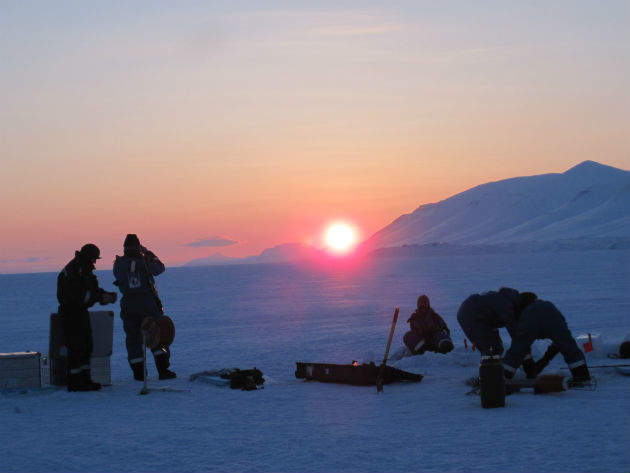
The oil and gas industry has made significant advances in detecting, containing and cleaning up oil spills, but freezing temperatures, remote locations and moving sea ice in the Arctic increase the risks of oil drilling and present unparalleled difficulties for any clean-up operation. Often, traditional methods, such as using a boon to absorb oil, are rendered useless in the icy water.

Discover B2B Marketing That Performs
Combine business intelligence and editorial excellence to reach engaged professionals across 36 leading media platforms.
The oil and gas industry has been researching a robust Arctic oil spill response for decades. In January 2012, collaboratively it launched an effort to enhance Arctic oil spill capabilities under the auspices of the International Association of Oil and Gas Producers (IOGP) called the Arctic Oil Spill Response Technology Joint Industry Programme (JIP). Its members include BP, Chevron, ConocoPhillips, Eni, ExxonMobil, North Caspian Operating Company (NCOC), Shell, Statoil, and Total.
According to the JIP, onshore and offshore Arctic production already accounts for 15% of the world’s energy supply and that is likely to grow in the future. Therefore, through field and laboratory research the JIP has set out to expand industry knowledge of, and proficiencies in, Arctic oil spill response in the key areas of: dispersants, environmental effects, trajectory modelling, remote sensing, mechanical recovery and in situ burning.
The JIP published its synthesis report in May detailing its findings, supported by a summary report. Here, JIP programme manager Joseph Mullin tells us more about the work.
Heidi Vella: Can you tell us about JIP’s keys findings after five years?
Joseph Mullin: The synthesis report covers how the JIP has improved capabilities to prepare more effective contingency plans for drilling and production programmes and oil spill response operational capabilities. However, the results of the JIP will enhance improved oil spill response in general, not just for operations in the Arctic and ice-prone waters.

US Tariffs are shifting - will you react or anticipate?
Don’t let policy changes catch you off guard. Stay proactive with real-time data and expert analysis.
By GlobalDataSome of the key outcomes of our work include finding new data on response effectiveness in different conditions which will inform decision-making at all levels, from planning through to response.
We have also created an information support tool that provides web-based access to 3,500 literature sources to assist firms when applying Net Environmental Benefit Analysis (NEBA) to future Arctic spill scenarios. This database [is] reducing the effort needed to identify and access the known, relevant information and will lead to a better understanding of the potential environmental effects of selecting different response strategies.
Furthermore, the JIP has better defined windows of opportunity and new data on expected response effectiveness for strategies involving dispersants, herders and burning that will improve contingency planning and enable more realistic training courses, drills and exercises to maintain and develop responder skills.
HV: What technologies did you identify as key to Arctic oil spill response?
JM: The JIP has built confidence in the available response tools and extended their capabilities with new strategies, systems and a better understanding of operating windows. Industry now has a more robust range of operationally proven tools to suit specific regional Arctic environments, encompassing ice and open water seasons.
HV: So, is current technology adequate enough or do improvements still need to be made?
JM: The development process will continue in the future as industry, academia and government scientists and engineers develop new oil spill research projects and ideas that build on and extend the JIP’s results.
This research needs to focus on experimental field releases in and around ice. This should incorporate, for example: demonstration of response strategies using icebreakers in conjunction with dispersant application; field-testing of the integrated herder/burn system; testing sensors over oil in natural ice; testing of sensor packages optimised for oil in ice detection and mapping with unmanned aerial systems (UAS), autonomous under water vehicles and remotely operated vehicle) on platforms; plus, developing operational, reliable UAS systems with sufficient payload capacity and endurance to apply herders and ignite spills in ice.
HV: What challenges did you face when conducting research for the report?
JM: When conducting project activities, adherence to safe working practices was of paramount importance. Contractors performing work on behalf of the JIP managed their project activities in such a manner as to reduce health, safety, and environmental risks to levels acceptable to the IOGP and the JIP executive committee. Above all, risks were managed so “no one gets hurt” and “no harm to the environment”.
Over the course of the five-year JIP, no accidents or injuries occurred.
HV: On the conclusion of this report, do you think the industry is better prepared to mitigate and manage a potential oil spill in the Arctic?
JM: The rigorous scientific process followed by the JIP should provide greater levels of confidence in Arctic oil spill response capabilities. Our work represents a significant achievement in this field. Its diverse suite of results covers many different response tools and important support activities that produce an effective integrated response system.
Because of past efforts and now this JIP, a range of operationally proven tools are available to suit specific regional environments, seasons, drilling and production programmes. This toolkit will ensure the most effective and environmentally beneficial response is deployed to protect the Arctic and other ice prone regions.
HV: What’s next for the JIP?
JM: We have been continually looking for new research and technology opportunities that could add value to the original suite of projects as results came in. This feedback forms a natural progression in extending the research boundaries in any field. The same process will continue in the future as industry, academia and government scientists and engineers develop new oil spill research projects and ideas that build on and extend the JIP’s results.





